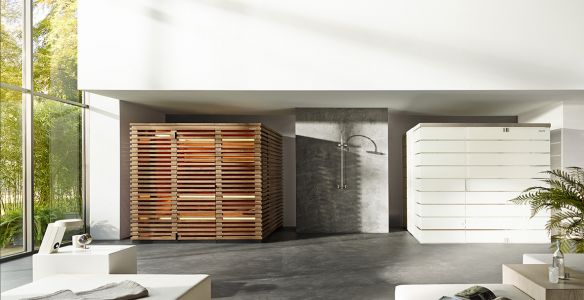Types of Spa and Wellness Facilities

Today we are going to tell you a little more about the various spa facilities.
Sauna
The sauna is a cabin with double steam and heat insulated prefabricated (prefabricated, prefabricated, panel) walls and wooden paneling. The heat source is supplied by an electric or gas heater coated with volcanic stones that generate and retain heat. The temperature in the sauna varies between 70°C and 100°C. There are different types of saunas, but the most popular is the Classic Wood-paneled Sauna, which mimics the earliest versions of the spa experience. In order to be energy efficient, sustainable over time and most of all useful to the users, the sauna must be an independent external structure, that is, be a room in the room, equipped with appropriate ventilation systems, patented electrical and control equipment.
Steam bath
It is often called "caldarium" or "sudatorium" because of its Roman equivalent. The steam room is a room in a room made of moisture-proof panels with appropriate waterproofing and vapor barrier materials and lined with artificial or natural stone. The facility temperature is from 42°C to 46°C, with 100% humidity generated by the hot steam, which in turn is created by hot water or more often introduced into the room by a steam generator. For even greater pleasure, aromas of essential oils are sprayed with the steam at the same time.
Hammam
Also known as a "Turkish bath" or "Moroccan hammam", contemporary hammam is usually larger than a steam bath. In the center of it is a „göbek taşı", or literally „navel stone", which is heated. A smaller version of the göbek taşı is also available in the adjacent room, adapted for individual soap massage. The heated floor, walls and benches heat the room to 40°C - 42°C, sometimes humidity reaches about 40-60% by using an independent steam source or evaporation of water through heated benches, floors and walls of the hammam. An authentic setting can be achieved if the room is lined with traditional Turkish colored fritware ceramic tiles from Iznik (historically known as Nicaea) and Carrara Blanco marble. In addition to these materials, there are many others through which an authentic oriental effect can be achieved.
Mud baths
Mud baths have emerged thousands of years ago as a medical and beautifying ritual - depending on the minerals contained in the mud, mud baths can clean, exfoliate, absorb harmful toxins, improve blood circulation and soften the skin. The bather can be fully immersed in the mud or in the mud to be applied to individual parts of the body by a therapist or partner.
Vitality pool
Vitality pool is the generic name for what we know as "Jacuzzi" (the name of the Jacuzzi® brand has become synonymous with all water jet pools). Vitality pools offer a small hydrotherapy experience for places that do not usually allow the construction of a large water pool. Such pools usually maintain a temperature between 35-38°C and offer underwater massage with pressurized air and other water "extras".
Laconium[1]
Another name from the Roman era. It is a warm ceramic room, with temperatures from 38°C to 42°C, in which visitors can relax for a long time in comfortable ergonomic benches, heated loungers or lounges. The walls, floor and benches are heated to allow heat to enter the body, making us feel good and rested. Different flavors can be injected through the humidifiers, creating an even cozier atmosphere. The heated lounges / benches are made of ceramics or stone (or other waterproof material), located in quiet areas around the wet areas of the SPA, because they are very suitable for "wet" relaxation between the various procedures.
Recreation areas
These places are known as "tepidariums" because they originate from Roman balneology; sometimes there were smaller, more secluded places for relaxation, even for sleep — they were called “refugiums”. Equipped with a range of beds and loungers, these locations are extremely important for any spa. When allocating spa space, we should pay attention to the fact that after a 10-minute stay in the sauna, it will take at least 20 minutes to equalize the body temperature with that of the environment and only then will the sauna user procedures can continue with sessions in the sauna and steam room. It is logical to have at least as many beds and loungers as there are in the SPA cabins and swimming pools.
[1]Laconium comes from Laconia in ancient Greek Sparta, not from ancient Rome
